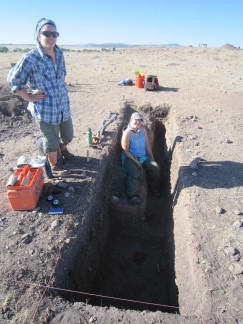- Home
- >
- Preservation Archaeology Blog
- >
- One Question Answered…
 |
By Katherine A. Dungan, Research Assistant
|

Somehow, we’re more than halfway through the field season—time really does fly out here!—and now it’s time to provide an update on our research. Older blog posts will give you an idea of how our fieldwork last summer shaped our understanding of the Fornholt site, so I’ll begin here by giving you a brief summary of our research goals for this summer.
First, we wanted to better understand what we think is a large kiva in Fornholt’s southern room block. Second, in light of the room full of burned corn we found last year, we wondered if there was evidence for additional burning in storage rooms. And third, we wanted to know whether the large depression located directly between the two thirteenth-century room blocks was a structure that may have been in use at the same time as the thirteenth-century occupation we are studying.
For this post, I’ll start with the last objective. Kelly has already written a great post about the (admittedly somewhat arduous) process of excavating this feature. Thanks to area supervisor Rob Jones, Kelly, and all of the other students who’ve worked in this feature, we now can see part of the floor, edge, and entryway of a large pit structure. They’ve recovered a handful of sherds from the floor. Some of these are Mimbres Black-on-white Style II (also known as “Transitional”). This strongly suggests that the structure was last used during the later part of the Three Circle Phase, around 900 to 1000 C.E.
We can’t tell exactly how large the structure was from the portion that we’ve excavated. Based on the size of the depression we can see at the site surface, however, we can say that this was probably a sizable structure and possibly a great kiva or ceremonial structure. One thing we can say with certainty is that it was retired long before the Tularosa Phase (13th c.) occupation.
Excavation in this area has given us a fascinating glimpse into the pithouse occupation at Fornholt, as well as a great sample of trash from throughout the history of the site. Our major research questions are about the Tularosa Phase occupation, however, so we won’t be expanding our excavations in this structure. I’ll post about our work in the Tularosa Phase southern room block and other research objectives soon.
Explore the News
-
Join Today
Keep up with the latest discoveries in southwestern archaeology. Join today, and receive Archaeology Southwest Magazine, among other member benefits.